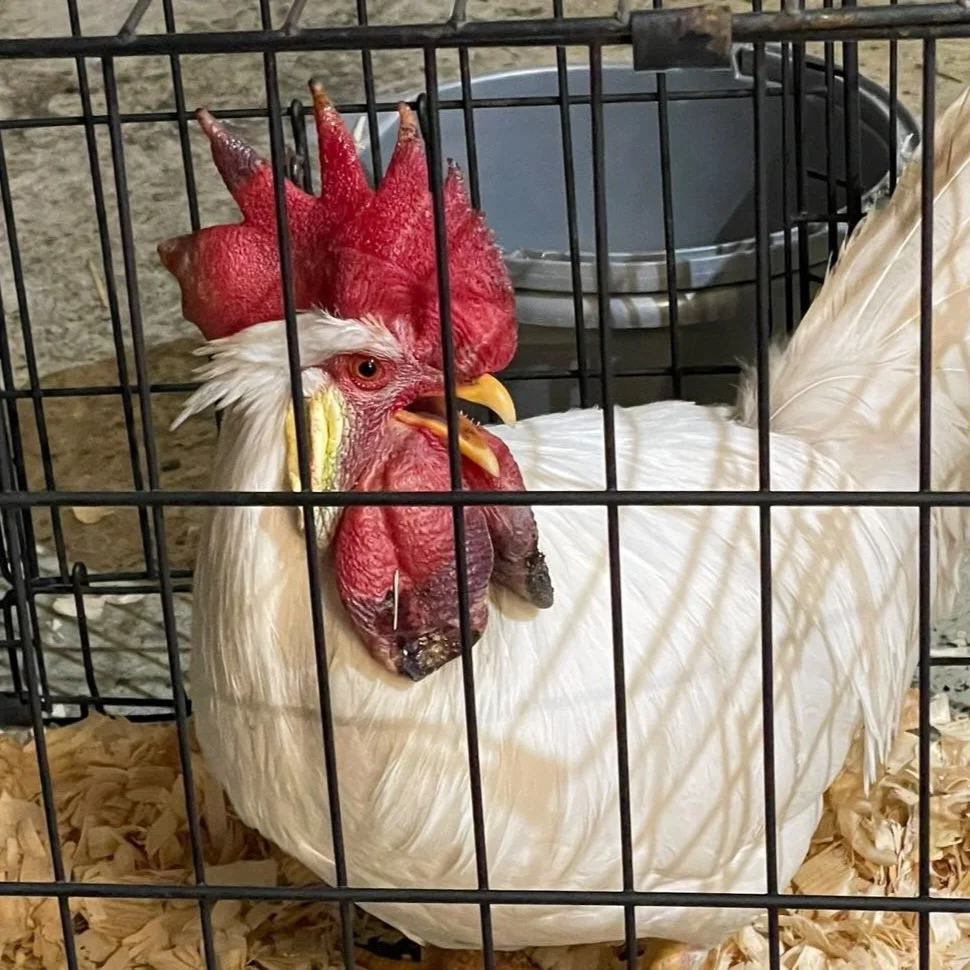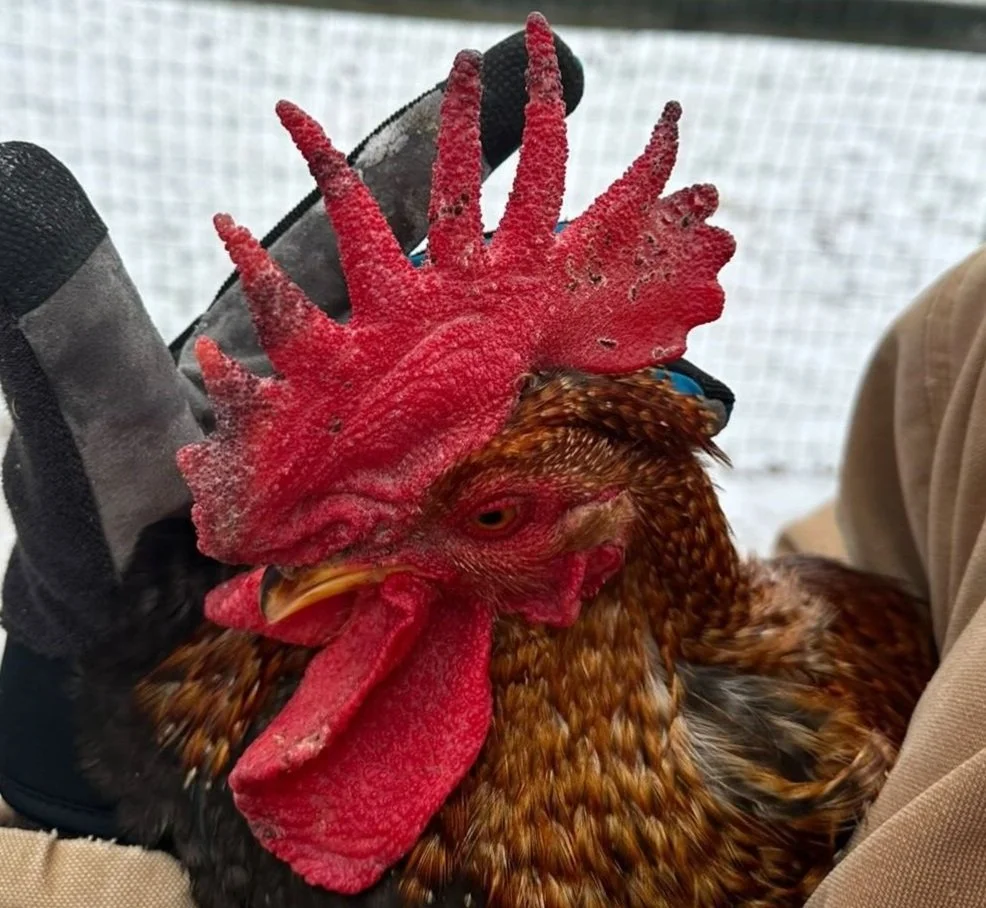How To prevent & treat Frostbite
in Chickens
Thank you to all of my followers who sent in photos so I could help educate others!
I earn a small commission on some of the links in this article at no extra cost to you. Thanks for the support!
My book is out for preorder so if you find this helpful, please consider grabbing a copy!
Causes and Prevention
Chickens are mostly prone to getting frostbite on their combs, wattles, and feet. When weather gets below freezing, exposed tissue is in danger. In below freezing conditions, a chicken’s vasodilation stops working in their extremities and causes parts of their body to freeze. Not only is frostbite painful, but chickens can get secondary infections or need amputations. Chickens can withstand cold temperatures and keep themselves from getting frost bite if they are kept dry, able to tuck their combs and wattles under their wing, and lay down on their feet. Let’s explore these a little more…
Winter can really be beautiful but harsh season. Doing some prep work before it hits is your best best in keeping your chickens dry and out of the wind. Wrap your chicken run in plastic to keep the wind, snow, and rain out. Cover and fill all drafts in the coop. Use old feed bags stapled onto the coop gaps. Close windows and cover with plastic if needed. Insulate the coop (we used 1 inch foam insulation board and plywood on top of that and our coop stays 10 degrees warmer than the outside air). Make sure you have good ventilation at the top of your coop to let warm moist air escape. Moist air will cling to extremities and cause freezing. If you notice frost on the inside of your windows, add more ventilation (this might also mean you have too many chickens for your coop size because their breathing can cause moisture to accumulate). Give your chickens clean dry bedding (We use hemp bedding from Eaton Pet and Pasture…use my code PURELYCHICKENS if you give them a try). Keep the run as dry as possible. Wet feet are more likely to get frostbite.
White tips on the comb and wattles are frostbite.
This chicken has frostbit wattles but the flat comb is okay.
Combs and wattles are the most common place to find frostbite. Most of the time, chickens can tuck their combs and wattles under their wings to keep them warm. Chickens who have large single combs or very large wattles have a hard time tucking them under their wings. This is why roosters are more likely to get frostbite. If you live in a climate with very cold temperatures where you aren’t able to keep your coop above freezing, you might consider getting chickens who have flatter combs. If you already have chickens with big combs, getting them an INFRARED HEATER will be helpful in preventing frost bite. Please don’t use a heat lamp or other heater that will make the coop toasty warm. The heater I linked raised the coop temperature about 2-3 degrees. To get benefit from it they need to be sitting under it. This is what you want because if you heat the coop they will not be ok if the power goes out or if they have to go outside of the coop. If you use an open waterer, chickens will dip their wattles in when drinking. This will then freeze and cause frostbite (please see the image to the right!) I like to train my chickens to use THIS TYPE of waterer to prevent this. You can also keep it heated with ONE OF THESE so it doesn’t freeze. THIS WATERER is smaller but plugs in and doesn’t require a separate heater. You can also apply my frostbite cream (recipe in my ESSENTIAL OIL ARTICLE and at the bottom of this one) to the combs and wattles to help prevent it from happening, but in extreme cold, nothing will help so use a safe heater to take the chill off a little.
This guy has a pretty severe case. The discoloration indicates that he needs treatment asap. The owner said they had used a heated bowl of water so his wattles were dipping in and caused frostbite.
Chicken feet & toes are also in danger of getting frostbite. They are walking around on cold ground and if they are in the snow or the ground is wet, that is even worse. Keep bedding dry and give them a place to roost where they can cover their feet completely. I use 2”x4” boards turned so the 4” side is up. Many people suggest this, but I will tell you, I used to have a coop with 2'“x2” roosts and none of my chickens ever had cold feet at night. Keeping their feet dry is so important. You do not need to have heated roosts either. It seems like a necessity but chickens are completely able to keep their feet warm just by laying down on them.
This chicken has just the beginning of frostbite. I would consider this to be early stages.
This chicken ha a much more severe case. His waddles are swollen.
Treatment
If preventative measures don’t work, or you are hit with an unexpected winter storm, you may have to deal with frostbite. There are different levels of frostbite. It starts with the skin turning white or grey as it starts to freeze. It will then turn purple or black. The skin can swell to be quite alarming and infection can happen as well. Frostbite is painful and dangerous. Minor cases need little treatment while extreme cases can result in amputation or even death. I will state here for the record, I am not a vet. If your chicken has frostbite, contact a vet in your area and get them help. Medications may need to be prescribed.
This is what I do for minor frostbite (minor as in just the tips of the comb are discolored).
Bring the chicken indoors. Do not use a heat source to warm them up. Let their skin come to room temperature slowly. If it is on their feet, you can use a lukewarm water foot soak. Do not use water over 100 degrees.
Do not remove or mess with the damaged tissue. Do not pop any blisters (in my opinion, blisters require a vet).
If the feet are damaged, keep the chicken in a crate with minimal space for moving around. Give him a soft bedding and no roost to jump off.
Use my frostbite cream daily to help the healing tissue, but melt it a little before applying so it is easier to apply and you don’t damage the tissue.
Do not let the chicken outside into freezing temperatures again while the tissue is healing. This can take several weeks.
If there is any swelling, bad discoloration, lameness, or blistering, please seek help from a vet.
Frostbite Cream
1 ounce beeswax
8 oz unrefined coconut oil
1 tsp vitamin e oil
5 drops lavender essential oil
5 drops frankincense essential oil
5 drops roman chamomile essential oil
Slightly melt the beeswax and coconut oils together in a saucepan. Once it cools, add the vitamin e and essential oils. Once cooled it will become solid. You can apply this to combs and wattles during cold weather.





